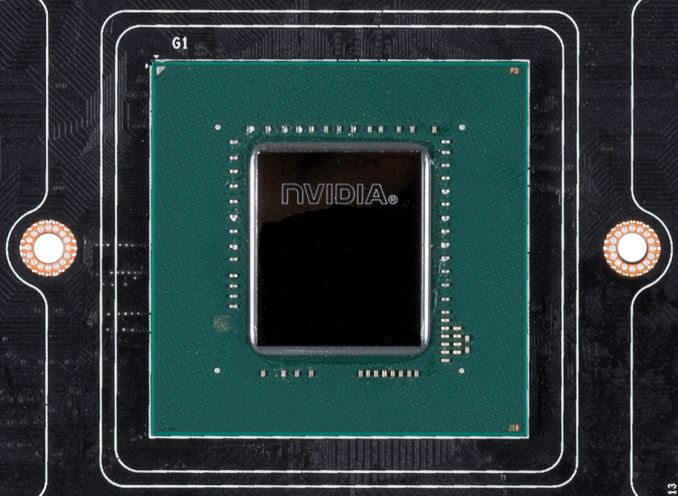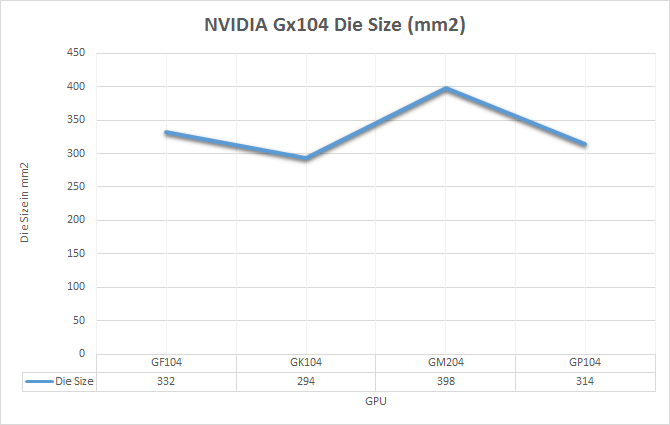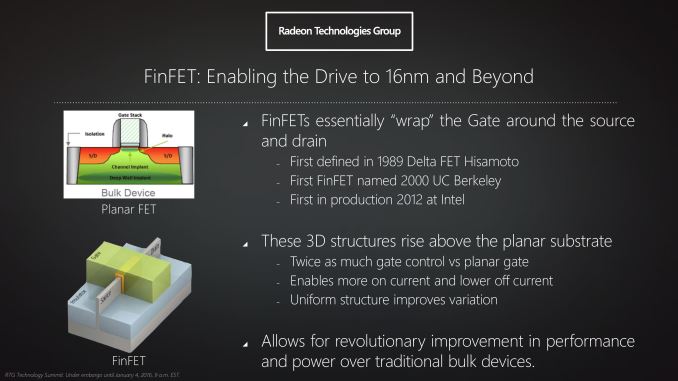The NVIDIA GeForce GTX 1080 & GTX 1070 Founders Editions Review: Kicking Off the FinFET Generation
by Ryan Smith on July 20, 2016 8:45 AM ESTGP104: The Heart of GTX 1080
At the heart of the GTX 1080 is the first of the consumer-focused Pascal GPUs, GP104. Though no two GPU generations are ever quite alike, GP104 follows a number of design cues established with the past couple 104 GPUs. Overall 104 GPUs have struck a balance between size and performance, allowing NVIDIA to get a suitably high yielding GPU out at the start of a generation, and to be followed up with larger GPUs later on as yields improve. With the exception of the GTX 780, 104 GPUs been the backbone of NVIDIA’s GTX 70 and 80 parts, and that is once again the case for the Pascal generation.
In terms of die size, GP104 comes in at 314mm2. This is right in NVIDIA’s traditional sweet spot for these designs, slotting in between the 294mm2 GK104 and the 332mm2 GF104. In terms of total transistors we’re looking at 7.2B transistors, up from 3.5B on GK104 and the 5.2B of the more unusual GM204. The significant increase in density comes from the use of TSMC’s 16nm FinFET process, which compared to 28nm combines a full node shrink, something that has been harder and harder to come by as the years have progressed.
Though the density improvement offered by TSMC’s 16nm process is of great importance to GP104’s overall performance, for once density takes a back seat to the properties of the process itself. I am of course speaking about the FinFET transistors, which are the headlining feature of TSMC’s process.
We’ve covered FinFET technology in depth before, so I won’t completely rehash it here. But in brief, FinFETs are an important development for chip fabrication as processes have gone below 28nm. As traditional, planar transistors have shrunk in feature size – and ultimately, the number of atoms they’re comprised of – electrical leakage has increased. With fewer atoms in a transistor, there are equally fewer atoms to control the flow of electrons.
FinFET in turn is a solution to this problem, essentially allowing fabs to turn back the clock on electrical leakage. By building transistors as three-dimensional objects with height as opposed to two-dimensional objects, giving FinFET transistors their characteristic fins in the process, FinFET technology greatly reduces the amount of energy a transistor leaks. In practice what this means is that FinFET technology not only reduces the total amount of energy wasted from leakage, but it also allows transistors to be operated at a much lower voltage, something we’ll see in depth with our analysis of GTX 1080.
FinFETs, or rather the lack thereof, are a big part of why we never saw GPUs built on TSMC’s 20nm process. It was TSMC’s initial belief that they could contain leakage well enough using traditional High-K Metal Gate (HKMG) technology on 20nm, a bet they ultimately lost. At 20nm, planar transistors were just too leaky to use for many applications, which is why ultimately we only saw SoCs on 20nm (and even then they were suboptimal). FinFETs, as it turns out, are absolutely necessary to get good performance out of transistors built on processes below 28nm.
And while it took TSMC some time to get there, now that they have the capability NVIDIA can reap the benefits. Not only can NVIDIA finally build a relatively massive chip like a GPU on a sub-28nm process, but thanks to the various beneficial properties of FinFETs, it allows them to take their designs in a different direction than what they could do on 28nm.













200 Comments
View All Comments
eddman - Wednesday, July 20, 2016 - link
That puts a lid on the comments that Pascal is basically a Maxwell die-shrink. It's obviously based on Maxwell but the addition of dynamic load balancing and preemption clearly elevates it to a higher level.Still, seeing that using async with Pascal doesn't seem to be as effective as GCN, the question is how much of a role will it play in DX12 games in the next 2 years. Obviously async isn't be-all and end-all when it comes to performance but can Pascal keep up as a whole going forward or not.
I suppose we won't know until more DX12 are out that are also optimized properly for Pascal.
javishd - Wednesday, July 20, 2016 - link
Overwatch is extremely popular right now, it deserves to be a staple in gaming benchmarks.jardows2 - Wednesday, July 20, 2016 - link
Except that it really is designed as an e-sport style game, and can run very well with low-end hardware, so isn't really needed for reviewing flagship cards. In other words, if your primary desire is to find a card that will run Overwatch well, you won't be looking at spending $200-$700 for the new video cards coming out.Ryan Smith - Wednesday, July 20, 2016 - link
And this is why I really wish Overwatch was more demanding on GPUs. I'd love to use it and DOTA 2, but 100fps at 4K doesn't tell us much of use about the architecture of these high-end cards.Scali - Wednesday, July 20, 2016 - link
Thanks for the excellent write-up, Ryan!Especially the parts on asynchronous compute and pre-emption were very thorough.
A lot of nonsense was being spread about nVidia's alleged inability to do async compute in DX12, especially after Time Spy was released, and actually showed gains from using multiple queues.
Your article answers all the criticism, and proves the nay-sayers wrong.
Some of them went so far in their claims that they said nVidia could not even do graphics and compute at the same time. Even Maxwell v2 could do that.
I would say you have written the definitive article on this matter.
The_Assimilator - Wednesday, July 20, 2016 - link
Sadly that won't stop the clueless AMD fanboys from continuing to harp on that NVIDIA "doesn't have async compute" or that it "doesn't work". You've gotta feel for them though, NVIDIA's poor performance in a single tech demo... written with assistance from AMD... is really all the red camp has to go on. Because they sure as hell can't compete in terms of performance, or power usage, or cooler design, or adhering to electrical specifications...tipoo - Wednesday, July 20, 2016 - link
Pretty sure critique was of Maxwell. Pascals async was widely advertised. It's them saying "don't worry, Maxwell can do it" to questions about it not having it, and then when Pascal is released, saying "oh yeah, performance would have tanked with it on Maxwell", that bugs people as it shouldScali - Wednesday, July 20, 2016 - link
Nope, a lot of critique on Time Spy was specifically *because* Pascal got gains from the async render path. People said nVidia couldn't do it, so FutureMark must be cheating/bribed.darkchazz - Thursday, July 21, 2016 - link
It won't matter much though because they won't read anything in this article or Futuremark's statement on Async use in Time Spy.And they will keep linking some forum posts that claim nvidia does not support Async Compute.
Nothing will change their minds that it is a rigged benchmark and the developers got bribed by nvidia.
Scali - Friday, July 22, 2016 - link
Yea, not even this official AMD post will: http://radeon.com/radeon-wins-3dmark-dx12/